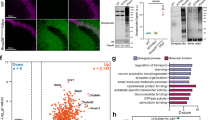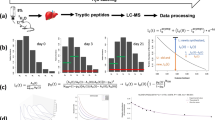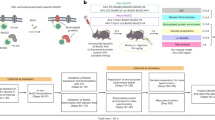Abstract
An important challenge for proteomics is to be able to compare absolute protein levels across biological samples1,2. Here we introduce an approach based on the use of culture-derived isotope tags (CDITs) for quantitative tissue proteome analysis. We cultured Neuro2A cells in a stable isotope-enriched medium and mixed them with mouse brain samples to serve as internal standards. Using CDITs, we identified and quantified a total of 1,000 proteins, 97–98% of which were expressed in both mouse whole brain and Neuro2A cells. CDITs also allow comprehensive and absolute protein quantification. Synthetic unlabeled peptides were used to quantify the corresponding proteins labeled with stable isotopes in Neuro2A cells, and the results were used to obtain the absolute amounts of 103 proteins in mouse whole brain. The expression levels correlated well with those in Neuro2A cells. Thus, the use of CDITs allows both relative and absolute quantitative proteome studies.
This is a preview of subscription content, access via your institution
Access options
Subscribe to this journal
Receive 12 print issues and online access
$209.00 per year
only $17.42 per issue
Buy this article
- Purchase on Springer Link
- Instant access to full article PDF
Prices may be subject to local taxes which are calculated during checkout



Similar content being viewed by others
References
Aebersold, R. & Mann, M. Mass spectrometry-based proteomics. Nature 422, 198–207 (2003).
Sechi, S. & Oda, Y. Quantitative proteomics using mass spectrometry. Curr. Opin. Chem. Biol. 7, 70–77 (2003).
Oda, Y. et al. Quantitative chemical proteomics for identifying candidate drug targets. Anal. Chem. 75, 2159–2165 (2003).
Ranish, J.A. et al. The study of macromolecular complexes by quantitative proteomics. Nat. Genet. 33, 349–355 (2003).
Blagoev, B. et al. A proteomics strategy to elucidate functional protein-protein interactions applied to EGF signaling. Nat. Biotechnol. 21, 315–318 (2003).
Oda, Y., Huang, K., Cross, F.R., Cowburn, D. & Chait, B.T. Accurate quantitation of protein expression and site-specific phosphorylation. Proc. Natl. Acad. Sci. USA 96, 6591–6596 (1999).
Pasa-Tolic, L. et al. High-thoughput proteome-wide precision measurements of protein expression using mass spectrometry. J. Am. Chem. Soc. 121, 7949–7950 (1999).
Wu, C.C., MacCoss, M.J., Howell, K.E., Matthews, D.E. & Yates, J.R. 3rd. Metabolic labeling of mammalian organisms with stable isotopes for quantitative proteomic analysis. Anal. Chem. 76, 4951–4959 (2004).
Jiang, H. & English, A.M. Quantitative analysis of the yeast proteome by incorporation of isotopically labeled leucine. J. Proteome Res. 1, 345–350 (2002).
Ong, S.E. et al. Stable isotope labeling by amino acids in cell culture, SILAC, as a simple and accurate approach to expression proteomics. Mol. Cell. Proteomics 1, 376–386 (2002).
Zhu, H., Pan, S., Gu, S., Bradbury, E.M. & Chen, X. Amino acid residue specific stable isotope labeling for quantitative proteomics. Rapid Mass Commun. Mass Spectrom. 16, 2115–2123 (2002).
Sagane, K., Yamazaki, K., Mizui, Y. & Tanaka, I. Cloning and chromosomal mapping of mouse ADAM11, ADAM22 and ADAM23. Gene 236, 79–86 (1999).
MacCoss, M.J., Wu, C.C., Liu, H., Sadygov, R. & Yates, J.R. 3rd. A correlation algorithm for the automated quantitative analysis of shotgun proteomics data. Anal. Chem. 75, 6912–6921 (2003).
Gygi, S.P. et al. Quantitative analysis of complex protein mixtures using isotope-coded affinity tags. Nat. Biotechnol. 17, 994–999 (1999).
Sakai, J., Kojima, S., Yanagi, K. & Kanaoka, M. (18)O-labeling quantitative proteomics using an ion trap mass spectrometer. Proteomics 5, 16–23 (2005).
Parker, K.C. et al. Depth of proteome issues: a yeast isotope-coded affinity tag reagent study. Mol. Cell. Proteomics 3, 625–659 (2004).
Mano, N., Oda, Y., Yamada, K., Asakawa, N. & Katayama, K. Simultaneous quantitative determination method for sphingolipid metabolites by liquid chromatography/ionspray ionization tandem mass spectrometry. Anal. Biochem. 244, 291–300 (1997).
Lensmeyer, G.L. & Poquette, M.A. Therapeutic monitoring of tacrolimus concentrations in blood: semi-automated extraction and liquid chromatography-electrospray ionization mass spectrometry. Ther. Drug. Monit. 23, 239–249 (2001).
Gunawan, S., Griswold, M.P. & Kahn, D.G. Liquid chromatographic-tandem mass spectrometric determination of amprenavir (agenerase) in serum/plasma of human immunodeficiency virus type-1 infected patients receiving combination antiretroviral therapy. J. Chromatogr. A. 914, 1–4 (2001).
Cass, R.T., Villa, J.S., Karr, D.E. & Schmidt, D.E. Jr. Rapid bioanalysis of vancomycin in serum and urine by high-performance liquid chromatography tandem mass spectrometry using on-line sample extraction and parallel analytical columns. Rapid Commun. Mass Spectrom. 15, 406–412 (2001).
Wilkinson, A.P., Wahala, K. & Williamson, G. Identification and quantification of polyphenol phytoestrogens in foods and human biological fluids. J. Chromatogr. B 777, 93–109 (2002).
Collingridge, G.L. & Isaac, J.T. Functional roles of protein interactions with AMPA and kainate receptors. Neurosci. Res. 47, 3–15 (2003).
Lerma, J. Roles and rules of kainate receptors in synaptic transmission. Nat. Rev. Neurosci. 4, 481–495 (2003).
Barr, J.R. et al. Isotope dilution—mass spectrometric quantification of specific proteins: model application with apolipoprotein A-I. Clin. Chem. 42, 1676–1682 (1996).
Gerber, S.A., Rush, J., Stemman, O., Kirschner, M.W. & Gygi, S.P. Absolute quantification of proteins and phosphoproteins from cell lysates by tandem MS. Proc. Natl. Acad. Sci. USA 100, 6940–6945 (2003).
Havlis, J. & Shevchenko, A. Absolute quantification of proteins in solutions and in polyacrylamide gels by mass spectrometry. Anal. Chem. 76, 3029–3036 (2004).
Katayama, H. et al. Efficient in-gel digestion procedure using 5-cyclohexyl-1-pentyl-beta-D-maltoside as an additive for gel-based membrane proteomics. Rapid Commun. Mass Spectrom. 18, 2388–2394 (2004).
Rappsilber, J., Ishihama, Y. & Mann, M. Stop and go extraction tips for matrix-assisted laser desorption/ionization, nanoelectrospray, and LC/MS sample pretreatment in proteomics. Anal. Chem. 75, 663–670 (2003).
Ishihama, Y., Rappsilber, J., Andersen, J.S. & Mann, M. Microcolumns with self-assembled particle frits for proteomics. J. Chromatogr. A 979, 233–239 (2002).
Acknowledgements
This work was supported by funds from New Energy and Industrial Technology Development Organization, Japan (NEDO).
Author information
Authors and Affiliations
Corresponding author
Ethics declarations
Competing interests
The authors declare no competing financial interests.
Supplementary information
Supplementary Table 1
Reproducibility of quantitative procedures using CDIT (including from affinity purification to MS analysis) (PDF 62 kb)
Supplementary Table 2
Linearity and its reproducibility of quantitative procedures using CDIT (PDF 65 kb)
Supplementary Table 3
Dependence of MS signal ratios (heavy/light) on the mixing ratios (brain and Neuro2A) (PDF 16 kb)
Supplementary Table 4
Protein list quantified by CDIT and ICAT (PDF 112 kb)
Supplementary Table 5
Same sequence pair versus different sequence pair as internal standard (PDF 18 kb)
Supplementary Table 6
Number of quantified proteins in mouse hippocampus (PDF 92 kb)
Supplementary Table 7
Hippocampal proteins showing more than 2-fold change between kainate-treated and untreated mice (PDF 21 kb)
Supplementary Table 8
Absolute amount of proteins in Neuro2A cells and mouse brains (PDF 16 kb)
Rights and permissions
About this article
Cite this article
Ishihama, Y., Sato, T., Tabata, T. et al. Quantitative mouse brain proteomics using culture-derived isotope tags as internal standards. Nat Biotechnol 23, 617–621 (2005). https://doi.org/10.1038/nbt1086
Received:
Accepted:
Published:
Issue Date:
DOI: https://doi.org/10.1038/nbt1086
This article is cited by
-
Costs of life - Dynamics of the protein inventory of Staphylococcus aureus during anaerobiosis
Scientific Reports (2016)
-
Xylem sap in cotton contains proteins that contribute to environmental stress response and cell wall development
Functional & Integrative Genomics (2015)
-
Chromatin enrichment for proteomics
Nature Protocols (2014)



